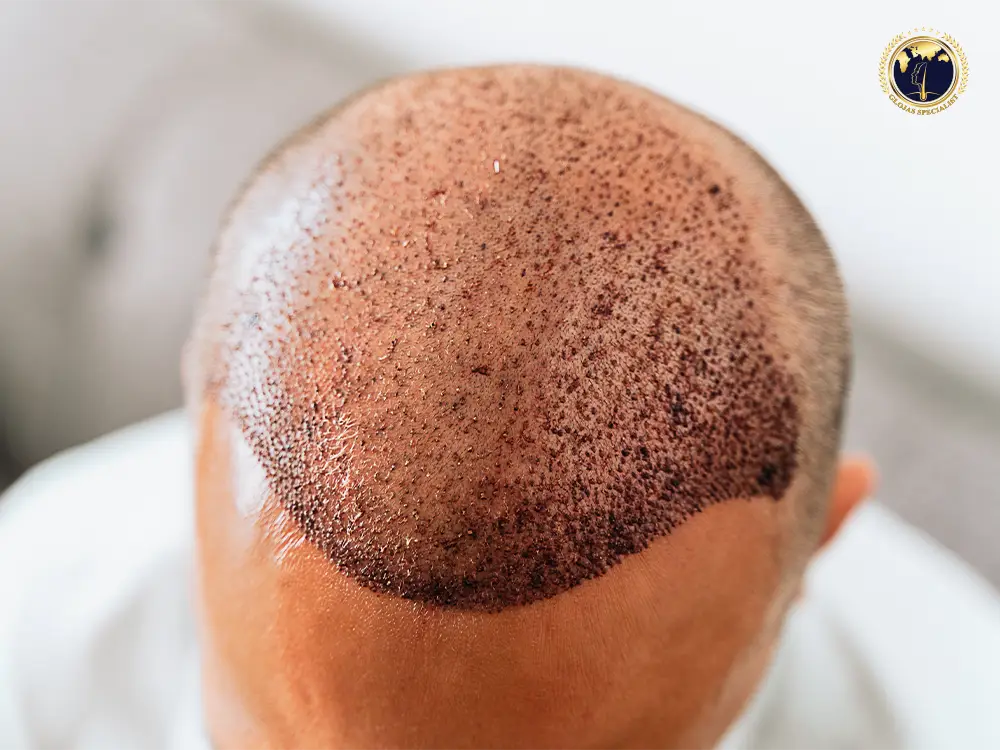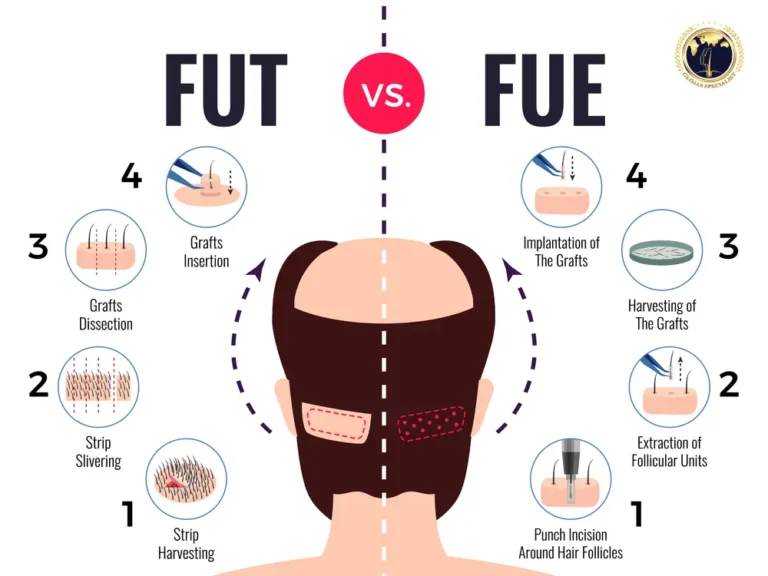FUE vs FUT Hair Transplant: Which Technique Is Better?
Hair loss can be a challenging experience, often leading individuals to seek permanent solutions like hair transplants. Among the most popular methods are Follicular Unit Extraction (FUE) and Follicular Unit Transplantation (FUT). Both techniques are effective in restoring hair, but they differ significantly in their procedures, recovery times, and outcomes. In this blog post, we’ll explore the differences between FUE hair transplant and FUT hair transplants, helping you make an informed decision about which method is best for you.
What Is FUE Hair Transplant?

Follicular Unit Extraction (FUE) is a modern hair transplant technique where individual hair follicles are extracted directly from the donor area, typically the back or sides of the scalp. These follicles are then implanted into the thinning or balding areas of the scalp.
How FUE Works
During an FUE procedure, a surgeon uses a micro-punch tool to remove hair follicles one by one. This method is minimally invasive and doesn’t require stitches, making it a popular choice for those looking for a less painful and quicker recovery process.
Advantages of FUE
- Minimal Scarring: Since FUE involves extracting individual follicles, it leaves tiny, almost invisible scars that are easily concealed even with short hair.
- Faster Recovery: Patients typically experience a quicker recovery time with less discomfort compared to FUT.
- Flexibility in Hairstyle: The lack of noticeable scarring means patients can comfortably wear their hair short after recovery.
Disadvantages of FUE
- Time-Consuming: The process of extracting individual follicles can be time-consuming, especially for larger areas.
- Cost: FUE is generally more expensive than FUT due to the meticulous nature of the procedure.
What Is FUT Hair Transplant?

Follicular Unit Transplantation (FUT), also known as the strip method, is a traditional hair transplant technique. In FUT, a strip of skin containing hair follicles is removed from the donor area. The strip is then dissected into individual follicular units, which are implanted into the balding areas.
How FUT Works
A surgeon removes a strip of scalp from the donor area, usually from the back of the head. The strip is then divided into smaller units under a microscope, and these units are implanted into the recipient area. The donor site is stitched up, leaving a linear scar.
Advantages of FUT
- Efficient for Large Areas: FUT allows a greater number of follicles to be transplanted in one session, making it ideal for covering larger bald areas.
- Lower Cost: FUT is generally less expensive than FUE, making it a more cost-effective option for many patients.
Disadvantages of FUT
- Visible Scarring: The linear scar from FUT can be visible if the hair is cut short, which may be a concern for some patients.
- Longer Recovery: Recovery from FUT can take longer and may involve more discomfort due to the incision and stitches.
FUE vs FUT: Key Differences Explained

Scarring
One of the most significant differences between FUE and FUT is the type of scarring. FUE leaves multiple tiny dot scars, while FUT results in a single linear scar. If you prefer wearing short hairstyles, FUE might be the better option due to its minimal scarring.
Procedure Time
FUE is more time-consuming than FUT because each follicle is individually extracted. In contrast, FUT can be completed faster, especially when large areas need to be covered.
Recovery
FUE generally offers a quicker and less painful recovery, while FUT may involve more discomfort and a longer healing time due to the nature of the strip removal.
Hair Density
FUT often provides a higher yield of hair grafts in a single session, which can be advantageous for those needing significant coverage. However, FUE allows for more precision in placing the grafts, which can lead to a more natural appearance in some cases.
Cost
FUE is usually more expensive than FUT, reflecting the more labor-intensive nature of the procedure. However, the choice should be based on personal preferences and the advice of a qualified surgeon rather than cost alone.
FUE vs FUT: How to Choose the Right Method
The decision between FUE and FUT should be based on several factors, including the extent of hair loss, the desired outcome, and your personal preferences regarding scarring and recovery time. Consulting with a skilled and experienced hair transplant surgeon is crucial to determine the best approach for your specific needs.
When to Choose FUE
- You want minimal scarring.
- You prefer a quicker recovery.
- You plan to wear short hairstyles.
When to Choose FUT
- You need a large number of grafts.
- You’re looking for a more cost-effective option.
- Scarring isn’t a significant concern.
FUE vs FUT: Final Thoughts
Both FUE and FUT hair transplants offer effective solutions for hair restoration, but they cater to different needs and preferences. Understanding the key differences between these techniques can help you make an informed decision that aligns with your goals and lifestyle. Remember to consult with a professional to discuss your options and achieve the best possible outcome for your hair restoration journey.
FUE vs FUT Hair Transplant FAQs
1. Which hair transplant method is more painful, FUE or FUT?
Both FUE and FUT are performed under local anesthesia, so pain during the procedure is minimal. However, FUT may cause more discomfort during recovery due to the stitches and larger incision.
2. Can FUE and FUT be combined in one treatment?
Yes, some surgeons may recommend a combination of FUE and FUT to maximize hair grafts and achieve optimal results, especially in patients with extensive hair loss.
3. How long does it take to see results after a hair transplant?
Initial hair growth can be seen within 3 to 4 months, with full results typically visible after 12 to 18 months as the transplanted hair gradually thickens.
4. Will the transplanted hair fall out?
It’s normal for the transplanted hair to shed within the first few weeks after the procedure. However, this is temporary, and new hair will begin to grow in its place.
5. Is one hair transplant session enough for complete coverage?
The number of sessions required depends on the extent of hair loss and the desired density. Some patients may need multiple sessions to achieve full coverage, particularly with larger bald areas.
Restore Your Hairline with SMART™ FUE Hair Transplant
At GLOJAS, our SMART™ FUE Hair Transplant is designed for men and women who want a natural, permanent, and confidence-boosting solution for hair loss. Unlike the traditional FUT method, which involves removing a strip of scalp and can leave visible scarring, FUE uses advanced micro-punch techniques to extract individual follicles. This results in:
Minimal Scarring: No linear scar, only tiny dot marks that heal quickly.
Faster Recovery: Most patients resume daily activities within a few days.
Natural Results: Grafts are carefully placed to match your natural hairline and density.
Choosing GLOJAS Specialist Clinic means choosing expertise. Led by experienced hair restoration doctors, our clinic combines cutting-edge technology with proven techniques to deliver consistent, world-class results. Every procedure is personalized to your hair loss stage, goals, and lifestyle.
👉 Whether you need a subtle hairline touch-up or high-density coverage, GLOJAS offers the perfect blend of safety, comfort, and artistry.
